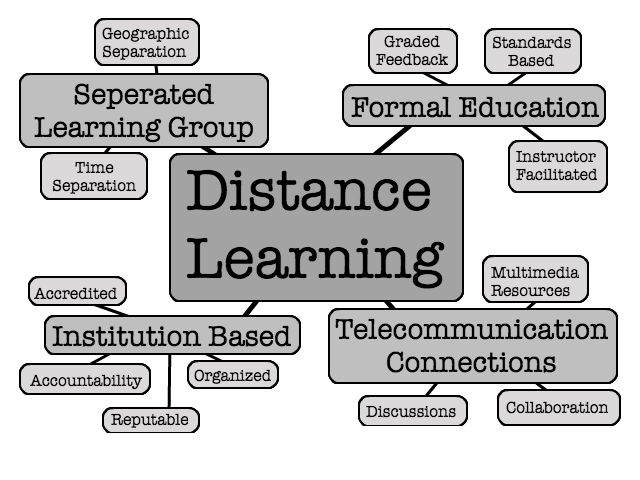
Before I undertook my venture into distance learning as a graduate student at Walden University I had very little experience with distance education, and in general would have considered it inferior to traditional classroom learning. I had known people who took distance learning classes in college and they mostly amounted to reading an excessive amount of written material and then writing reviews on what they read and turning them in to the institution. I did not see in this the meaningful interaction, discourse, and collaboration that students have with one another and their instructors in traditional classrooms, and this to me was the main reason for formal education. As someone who had been home-schooled through much of my k-12 education I was very much aware that education could occur outside the classroom and that formal institutions were not a necessary part of learning, so in my view at the time a person might as well be self-taught as participate in distance education. However, now, having participated in the effective form of interactive, discussion and project-based distance education offered by Walden University I can see the value and the effectiveness of this type of education.
Distance learning (or distance education) has been defined as “institution-based, formal education where the learning group is separated, and where interactive telecommunications systems are used to connect learners, resources, and instructors” (Simonson, 2009, 2010). This is probably a good working definition for the time being because it encapsulates the primary traits of distance education: it must be facilitated by a formal institution, it involves students being separated by space (as well as time, quite often) from their instructor and one another, and it uses technology to connect them. This has not always been the definition, however, and even now it is not universally accepted. Some instructional designers and learning theorists continue looking forward as well, seeking new ways to redefine what distance education is and how it is done.
Since distance education existed before the invention of electronic telecommunications, obviously this was not always considered an integral part of the the distance learning experience. Correspondence courses can be traced back to over 160 years ago. The concept of distance learning seems to have arisen and expanded alongside the new middle-class. Thees were “adults with occupational, social, and family commitments,” seeking the “opportunity to widen intellectual horizons, as well as the chance to improve and update professional knowledge” (Simonson, 2014). This continues to be the primary group participating in distance education to this day.
Although distance education continues to be used primarily by working adults for the same reasons or which it was originally invented much has changed in how it is presented and carried out. The biggest change is obviously the invention of interactive electronics telecommunication technology. Each time a new telecommunications medium has been invented it has been used for distance education: first the radio, then the t.v., and finally the internet (Simonson, 2014). The the power of the internet students are able to interact in a manner much more closely resembling the conversation and collaboration they would participate in with classroom-based education. T.V. and radio are mediums that excel at decimating information, but offer very little in the way of an interactive experience.
The arrival of the internet has revolutionized distance education as it has the entire education economy. The lack of interactivity is a huge concern since students interacting with their instructor, their environment and each other, “as well as active learning in the classroom is vital for any distance learning program” (McNabb, 1994). Millbank (1994) even found that the learners’ retention rate increased from 20 to 75 percent when he introduced audio and video components with real-time interactivity in his courses. These types of interactions were only possible on large scale with the arrival of the internet, so it is only within the past couple decades that it has been possible for distance education to begin to truly produce a comparable learning experience to what students might receive in a traditional classroom.
Given how quickly technology continues to advance I believe we can look forward to innovations continuing to elevate distance education to more effectively reach the needs of learners. Edwards (1995) spoke about the need to move from mass-produced courseware made for a mass market in distance education, towards what he referred to as “open learning”: education that focuses “on local and individual needs and requirements.” This concept of open learning, I perceive to be closely related to the idea of Self-directed learning, “in which individuals take the initiative with or without the help of others, in diagnosing their learning needs, formulating learning goals, identifying resources for learning, choosing and implementing learning strategies and evaluating learning” (Ramnarayan & Hande, 2005). The more educators and students can move towards this type of learning the more meaningful and fruitful education becomes, and without many of the confines of physical classroom spaces, distance learning offers an exciting potential for self-directed, open learning. This is what I hope to see become a regular reality with distance learning in the near future.
References:
Edwards, R. (1995). Different discourses, discourses of difference: Globalisation, distance education, and open learning. Distance Education, 16(2), 241–255.
McNabb, J. (1994, October). Telecourse effectiveness: Findings in the currentliterature. Tech Trends, 39-40.
Millbank, G. (1994). Writing multimedia training with integrated simulation. Paper presented at the Writers’ Retreat on Interactive Technology and Equipment. Vancouver, BC: The University of British Columbia Continuing Studies.
Ramnarayan, K. & Hande, S. (2005). Thoughts on Self-Directed Learning in Medical Schools: Making Students More Responsible. Johns Hopkins University. Retrieved 5/8/16 (http://education.jhu.edu/PD/newhorizons/lifelonglearning/higher-education/medical-schools/)
Simonson, Michael. Teaching and Learning at a Distance. Information Age Publishing, 10/2014. VitalBook file.
Simonson, M. (2009). Distance learning. In The 2009 book of the year (p. 231). Chicago, IL: Encyclopaedia Britannica.
Simonson, M. (2014). Teaching and Learning at a Distance (p. 38). Information Age Publishing. VitalBook file.
